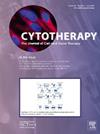Overexpression of PD-L1 in mesenchymal stem/stromal cells and their derived extracellular vesicles enhances immunomodulatory properties and therapeutic efficacy in nonobese diabetic mice
IF 3.7
3区 医学
Q2 BIOTECHNOLOGY & APPLIED MICROBIOLOGY
引用次数: 0
Abstract
Background & Aim
Type 1 diabetes (T1D) is an autoimmune disease characterized by the destruction of pancreatic β cells, necessitating lifelong insulin therapy. Programmed death ligand-1 (PD-L1) is critical in maintaining peripheral tolerance and immunological homeostasis. This study investigates the protective effects of mesenchymal stem/stromal cells (MSCs) overexpressing PD-L1 and their derived extracellular vesicles (PEVs) in murine models of T1D.
Methodology
PD-L1-engineered MSCs (PD-L1-MSCs) were generated by infecting human bone marrow-derived MSCs with a lentiviral vector encoding the human PD-L1 gene. The immunosuppressive properties and impact on islet cell death of PD-L1 MSCs and PEVs were evaluated in vitro by coculturing them with peripheral blood mononuclear cells (PBMCs) and murine islets. For the in vivo study, 8-week-old female NOD mice were given a single IV infusion of MSCs (n=17), PD-L1-MSCs (n=18), MSC-EVs (n=20), PEVs (n=20), or PBS (control, n=20), respectively. Blood glucose levels were monitored weekly for 25 weeks. In separated groups of mice, the pancreas, pancreatic lymph nodes (PLN), and spleen were collected 3 weeks post-treatment to assess immune cell infiltration, T cell profiling and function via H&E staining and flow cytometry. Statistical differences were analyzed using one-way ANOVA with post-hoc correction.
Results
In vitro, PD-L1-MSCs and PEVs effectively suppressed T cell proliferation and increased T regulatory cells (Tregs, p<0.01 vs. control), highlighting their immunomodulatory potential. Islet viability was significantly improved when cocultured with PD-L1-MSCs (viability: 75.3±5.3%) or PEVs (91.3±1.9%), vs. controls (59.9±6.0%, p<0.05 vs control in each group). In vivo, PD-L1-MSCs or PEVs significantly reduced blood glucose and delayed T1D onset in NOD mice (CTR vs. PD-L1-MSC, p<0.05; CTR vs. PEV, p<0.01, Logrank test). H&E staining showed a significant decrease in immune cell infiltration in the pancreatic islets. In PLN, PD-L1 MSCs or PEVs decreased CD8+ T cell number (p< 0.03 vs control), and increased CD8+ T cell exhaustion and Tregs.
Conclusion
These findings suggest that PD-L1 overexpression in MSCs enhances their immunosuppressive and protective effects on pancreatic islets, partly by enhancing Tregs and CD8+ T cell exhaustion. This underscores the therapeutic potential of PD-L1-MSCs and PEVs in modulating immune responses in T1D and reveals the underlying cellular mechanisms.
间充质干细胞/基质细胞及其衍生的细胞外囊泡中PD-L1的过度表达增强了非肥胖糖尿病小鼠的免疫调节特性和治疗效果
背景,1型糖尿病(T1D)是一种以胰腺β细胞破坏为特征的自身免疫性疾病,需要终身胰岛素治疗。程序性死亡配体-1 (PD-L1)在维持外周耐受和免疫稳态中起着关键作用。本研究探讨了过表达PD-L1的间充质干细胞/基质细胞(MSCs)及其衍生的细胞外囊泡(PEVs)在小鼠T1D模型中的保护作用。方法用编码人PD-L1基因的慢病毒载体感染人骨髓源性MSCs,制备PD-L1-MSCs。通过体外与外周血单核细胞(PBMCs)和小鼠胰岛共培养,研究PD-L1 MSCs和PEVs的免疫抑制特性及其对胰岛细胞死亡的影响。在体内研究中,8周龄雌性NOD小鼠分别给予单次静脉输注MSCs (n=17)、PD-L1-MSCs (n=18)、msc - ev (n=20)、PEVs (n=20)或PBS(对照,n=20)。每周监测血糖水平,持续25周。各组小鼠分别于治疗后3周采集胰腺、胰淋巴结(PLN)和脾脏,通过H&;E染色和流式细胞术评估免疫细胞浸润、T细胞谱和功能。统计学差异分析采用单因素方差分析和事后校正。结果PD-L1-MSCs和PEVs在体外可有效抑制T细胞增殖,增加T调节性细胞(Tregs, p<0.01),显示其免疫调节潜能。与PD-L1-MSCs(75.3±5.3%)或pev(91.3±1.9%)共培养时,胰岛细胞活力显著提高,而对照组(59.9±6.0%,各组与对照组相比差异0.05)。在体内,PD-L1-MSC或PEVs显著降低NOD小鼠血糖并延缓T1D发病(CTR vs. PD-L1-MSC, p<0.05;CTR vs. PEV, p<0.01, Logrank检验)。H&;E染色显示胰岛免疫细胞浸润明显减少。在PLN中,PD-L1 MSCs或PEVs减少CD8+ T细胞数量(p<;0.03 vs对照组),CD8+ T细胞耗竭和Tregs增加。结论MSCs中PD-L1过表达增强了其对胰岛的免疫抑制和保护作用,其机制部分是通过增强Tregs和CD8+ T细胞耗竭来实现的。这强调了PD-L1-MSCs和pev在调节T1D免疫反应方面的治疗潜力,并揭示了潜在的细胞机制。
本文章由计算机程序翻译,如有差异,请以英文原文为准。
求助全文
约1分钟内获得全文
求助全文
来源期刊

Cytotherapy
医学-生物工程与应用微生物
CiteScore
6.30
自引率
4.40%
发文量
683
审稿时长
49 days
期刊介绍:
The journal brings readers the latest developments in the fast moving field of cellular therapy in man. This includes cell therapy for cancer, immune disorders, inherited diseases, tissue repair and regenerative medicine. The journal covers the science, translational development and treatment with variety of cell types including hematopoietic stem cells, immune cells (dendritic cells, NK, cells, T cells, antigen presenting cells) mesenchymal stromal cells, adipose cells, nerve, muscle, vascular and endothelial cells, and induced pluripotential stem cells. We also welcome manuscripts on subcellular derivatives such as exosomes. A specific focus is on translational research that brings cell therapy to the clinic. Cytotherapy publishes original papers, reviews, position papers editorials, commentaries and letters to the editor. We welcome "Protocols in Cytotherapy" bringing standard operating procedure for production specific cell types for clinical use within the reach of the readership.
 求助内容:
求助内容: 应助结果提醒方式:
应助结果提醒方式:


